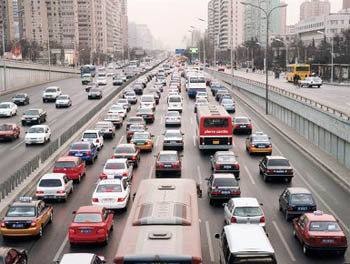Megacities look at public transport traffic jams increase
 Hamburg - Chinese efforts at curbing smog during the Olympic Games by banning half of the 3 million vehicles from Beijing's roads has highlighted the problems caused by mass motorisation in the world's megacities.
Hamburg - Chinese efforts at curbing smog during the Olympic Games by banning half of the 3 million vehicles from Beijing's roads has highlighted the problems caused by mass motorisation in the world's megacities.
Seven of the world's biggest cities with a population of more than 10 million currently exceed World Health Organisation (WHO) guidelines on air pollution.
The problem is caused mainly by a growing population of older and badly maintained cars which spewing excess sulphur dioxide, diesel particulates and carbon monoxide into the air.
With millions of people moving from rural to urban areas in search of jobs and better-earners buying cars, a larger proportion of people in many countries are feeling the effects of bad air quality.
Beijing, which is seeing its traffic grow by about 1,200 vehicles per day, is one of the world's most polluted cities along with Jakarta, Cairo, Mexico City, Los Angeles, Sao Paulo and Moscow.
According to estimates by the World Bank, the booming private car ownership in India and China will lead to more cars being built in the next two decades than in the past 110 years of the motor car.
Most of these motorists will have to spend more and more time stuck in traffic jams unless governments introduce "green" ways out of the dilemma by persuading commuters to use public transport. Already cities are reacting:
In London, Europe's largest city, authorities have introduced a congestion charge of eight pounds (15.60 dollars) per day for every vehicle entering the city. The city is using the income to buy more buses including hybrid buses that use 30 per cent less fuel. Car traffic in the city centre has been reduced by 20 per cent with air pollution falling by 15 per cent.
In the Colombian city of Bogota, mayor Enrique Penalosa has introduced an innovative public bus transportation system, the TransMilenio, that could serve as an example for many developing countries. A separate 84-kilometre bus lane network significantly improved the flow of traffic, reducing pollution and the number of road deaths at the same time.
The notoriously bad air in Teheran has improved recently with measures including fines for peak hour traffic, petrol rationing, introduction of buses running on natural gas and the removal of older cars from the road.
In the French city of Strasbourg the city revived the tram system in 1994 after it was given up in the 1960s. Major inner city roads have been closed to cars and replaced by a park-and-ride system.
As the pace of private car ownership increases, authorities are reacting by limiting where and when people can drive their cars.
The Cities for Mobility, a network of 260 cities across four continents, (www. cities-for-mobility. net) is promoting projects for more sustainable and efficient transportation systems.
At its recent world congress in the German city of Stuttgart, mayor Wolfgang Schuster tested a new form of transport that he hopes will become the means of mobility for commuters in the German "smog capital" - the Pedelec. The bicycle is supported by a small electric motor, making cycling uphill much easier.
It is already booming in China where some 20 million Pedelecs were sold last year. (dpa)